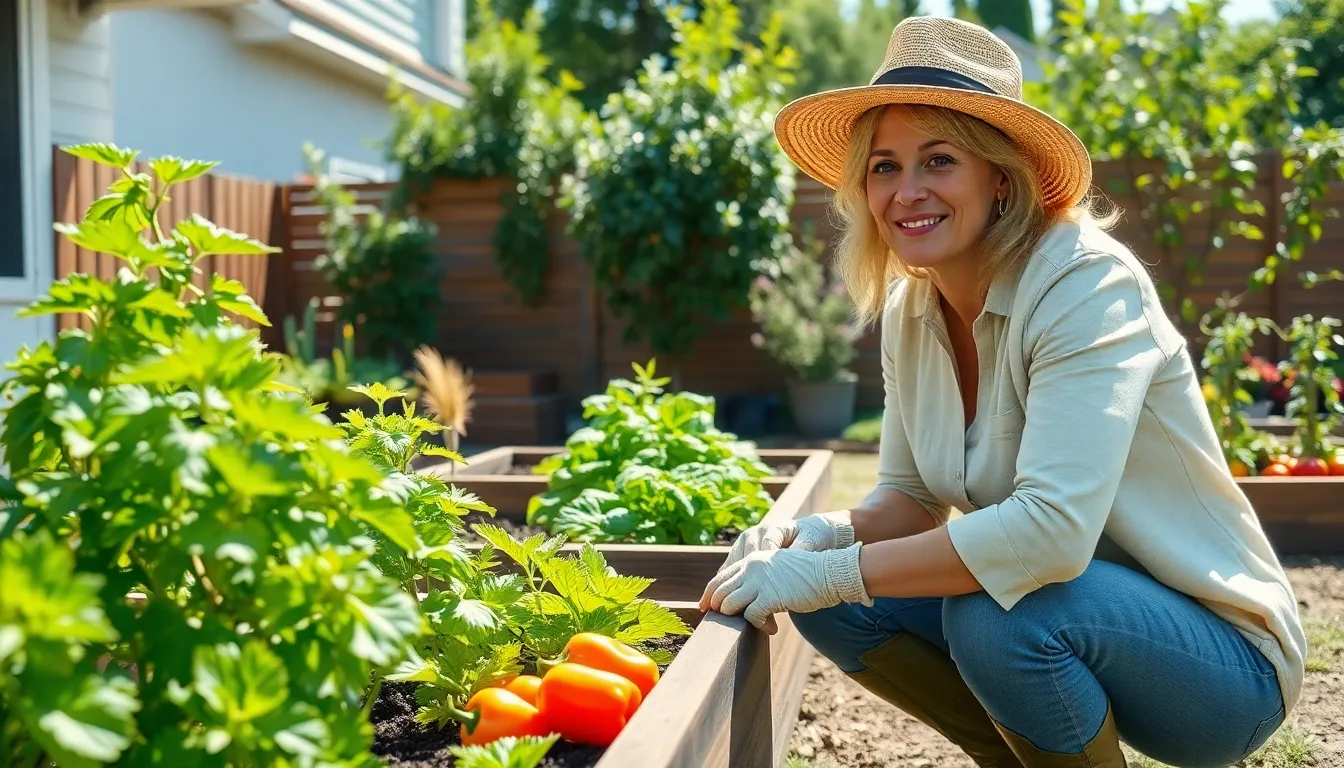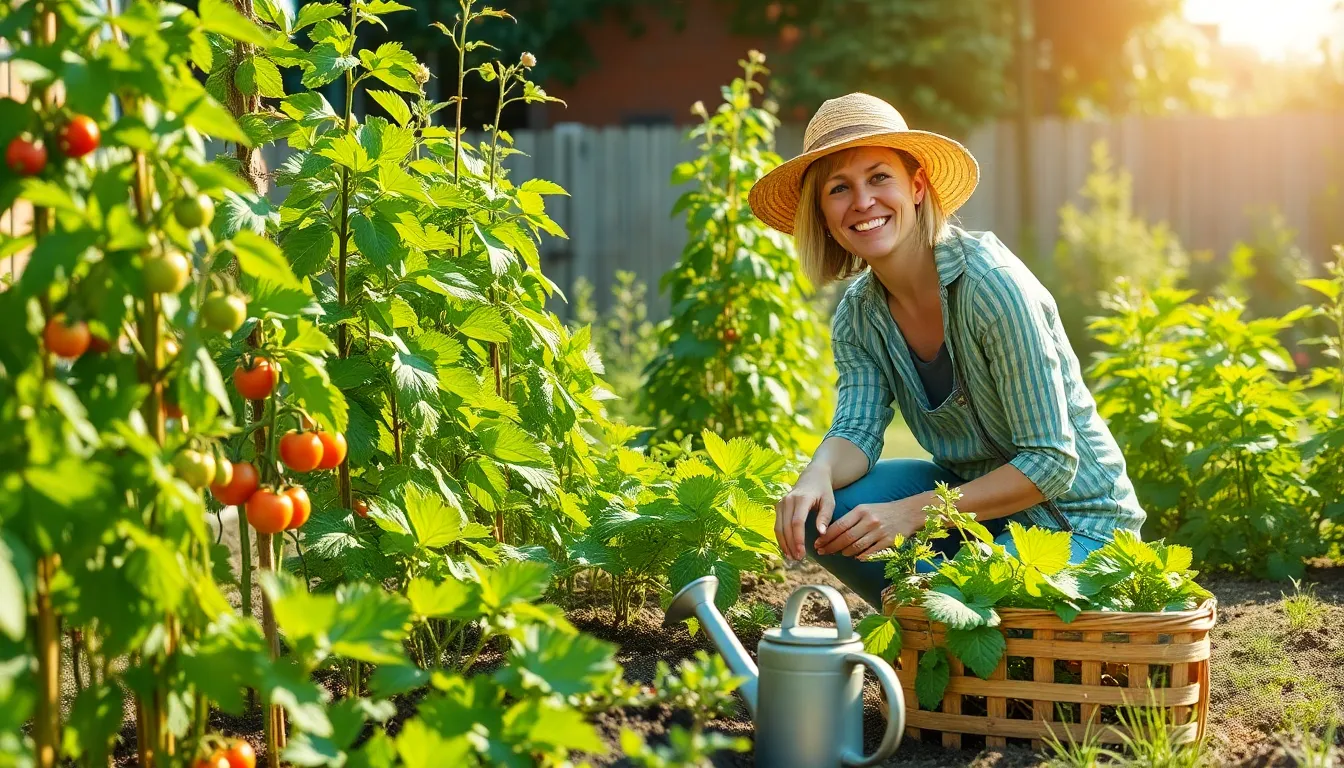Imagine stepping into your backyard and being greeted by a vibrant patch of green, where the air is filled with the scent of fresh tomatoes and crisp cucumbers. A vegetable garden isn’t just a feast for the eyes; it’s a ticket to homegrown goodness that can elevate meals from mundane to magnificent. Plus, who wouldn’t want to brag about their homegrown veggies at the next barbecue?
Vegetables Garden
Starting a vegetable garden provides numerous advantages that contribute to overall well-being and the environment. These benefits encompass health improvements and positive ecological impacts.
Health Benefits
Growing vegetables promotes better nutrition. Homegrown produce often has higher nutrient levels compared to store-bought options. Consuming fresh vegetables enhances diets, supporting heart health, digestion, and overall wellness. Gardening also encourages physical activity, providing exercise through planting, weeding, and harvesting. Engaging with nature can reduce stress and improve mental health, leading to a more balanced lifestyle. Moreover, enjoying fresh vegetables can foster healthier eating habits, encouraging more plant-based meals for individuals and families.
Environmental Benefits
Starting a vegetable garden helps the environment in several ways. It reduces the carbon footprint associated with transporting produce from farms to stores. Using organic gardening practices minimizes chemical pesticide use, benefiting local ecosystems. Additionally, home gardens promote biodiversity by attracting beneficial insects and pollinators. Water conservation practices, such as drip irrigation or rainwater collection, become more manageable in backyard gardens. Gardening also improves soil health, enhancing its ability to sequester carbon and support a diverse range of plant and animal life.
Planning Your Vegetables Garden

Planning a vegetables garden involves thoughtful considerations to ensure success and enjoyment. Factors like location and vegetable selection play crucial roles in the overall garden experience.
Choosing The Right Location
Selecting an optimal spot maximizes sunlight exposure, typically needing at least six hours daily. Consider proximity to a water source for convenient irrigation. Look for well-draining soil, as it prevents waterlogging, which can harm plants. Avoid shaded areas near large trees or buildings, as reduced light stunts growth. Prioritize accessibility for maintenance, ensuring easy access for watering, weeding, and harvesting.
Selecting The Best Vegetables
Choosing vegetables aligns with growing conditions and personal preferences. Start with easy-to-grow varieties like tomatoes, lettuce, and peppers, which thrive in various conditions. Assess the climate zone to determine suitable choices that flourish throughout the growing season. Include staple crops for regular meals and consider staggered planting for continuous harvests. Research companion planting techniques to enhance growth and reduce pest issues, aiding overall garden health.
Preparing The Soil
Preparing the soil lays the foundation for a successful vegetable garden. Healthy soil supports robust plant growth and abundant yields.
Soil Testing
Soil testing identifies nutrient levels and pH balance. Conduct tests using soil samples from various garden spots. A balanced pH, typically around 6 to 7, promotes optimal vegetable growth. Testing kits provide quick results and professional labs offer detailed analysis. After testing, gardeners understand how to adjust nutrient levels for specific crops.
Amending The Soil
Amending the soil enhances its fertility and structure. Gardeners add organic matter, such as compost or well-rotted manure, to enrich the soil. Incorporating materials improves drainage and boosts nutrient availability. Additionally, adding perlite or vermiculite can enhance aeration and root development. Regular amendments refresh the soil, promoting ongoing health and productivity.
Planting Techniques
Effective planting techniques impact the success of a vegetable garden. Two primary methods stand out: direct seeding and transplanting seedlings.
Direct Seeding
Direct seeding involves planting seeds directly into the garden bed. Seed depth varies by vegetable, generally ranging from 1/4 inch to 2 inches. This method allows seeds to germinate right where they will grow, promoting stronger root development. Weather conditions should influence the timing of seeding, ideally during the recommended planting window for each vegetable. Plant cold-tolerant seeds, like peas and radishes, in early spring. For warm-season vegetables, such as beans and squash, consider planting after the last frost. Adequate watering ensures proper germination and initial growth, as soil moisture is crucial for success.
Transplanting Seedlings
Transplanting seedlings involves starting seeds indoors or in a controlled environment before moving them outside. This technique is beneficial for vegetables with longer growing seasons, such as tomatoes and peppers. Seedlings thrive when starter pots provide a nurturing environment, allowing them to mature before facing outdoor conditions. Timing dictates the transplanting schedule; seedlings typically go outside after the last frost date. Gradually acclimate seedlings to outdoor conditions through a hardening-off process, which reduces transplant shock. Proper spacing between transplants supports healthy growth and airflow, reducing disease risks. Water seedlings immediately after transplanting to establish strong connections with the soil.
Maintenance Tips
Maintaining a vegetable garden ensures continued growth and productivity. Consistent care leads to abundant harvests and healthier plants.
Watering Strategies
Water vegetables deeply once or twice a week, depending on weather conditions. Soil moisture should be consistently monitored; it’s essential to keep it damp but not saturated. Plants benefit from watering in the early morning to prevent evaporation. Drip irrigation systems work effectively, as they deliver moisture directly to the roots. During dry spells, mulch retains soil moisture and reduces weeds, creating a stable environment. Regular watering maintains healthy plants.
Pest Control Methods
Implement integrated pest management to safeguard the vegetable garden. Beneficial insects, such as ladybugs and lacewings, naturally control pests. Crop rotation also reduces the chances of infestations by disrupting pest life cycles. Additionally, organic pesticides and neem oil address infestations without harming the environment. Inspect plants regularly for any signs of damage or pests; early detection makes handling easier. Keeping the garden clean by removing debris reduces hiding spots for pests and promotes better overall health.
Conclusion
Starting a vegetable garden is a rewarding endeavor that offers numerous benefits. Not only does it provide fresh produce for meals but it also fosters a deeper connection with nature. The joy of nurturing plants and sharing the harvest can enhance social gatherings and personal well-being.
By following the right planning and maintenance techniques, anyone can cultivate a thriving garden. From soil preparation to effective watering and pest management, these practices ensure a bountiful harvest. Embracing the journey of gardening not only contributes to better health but also promotes environmental sustainability. With dedication and care, a vegetable garden can flourish, bringing joy and nourishment for years to come.

